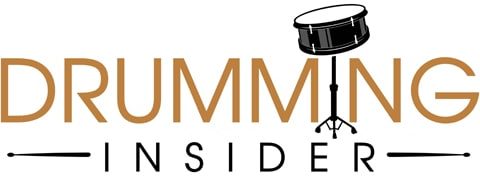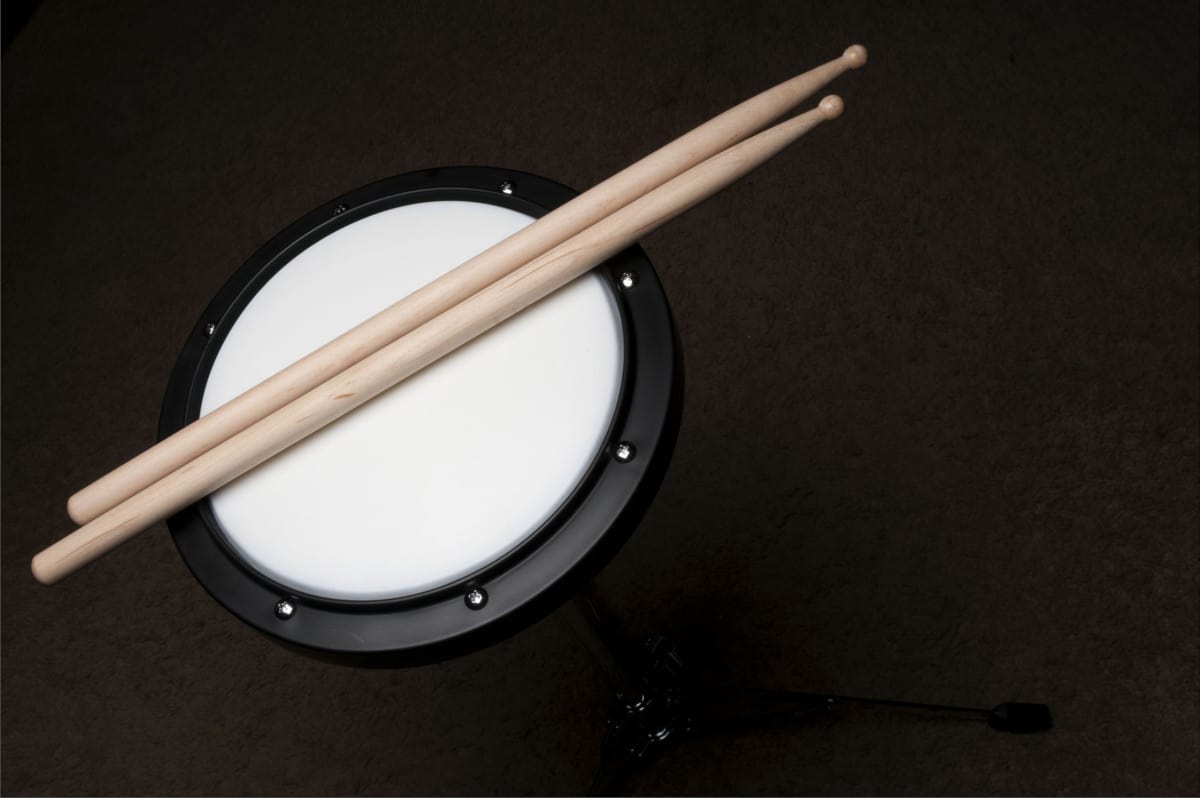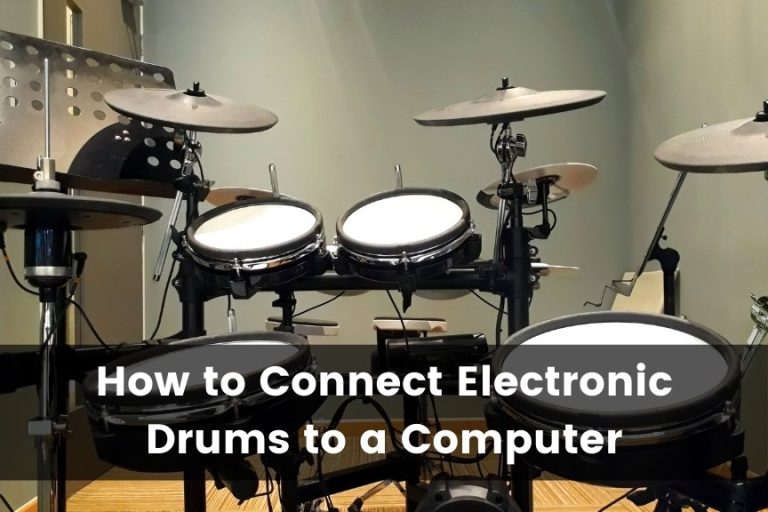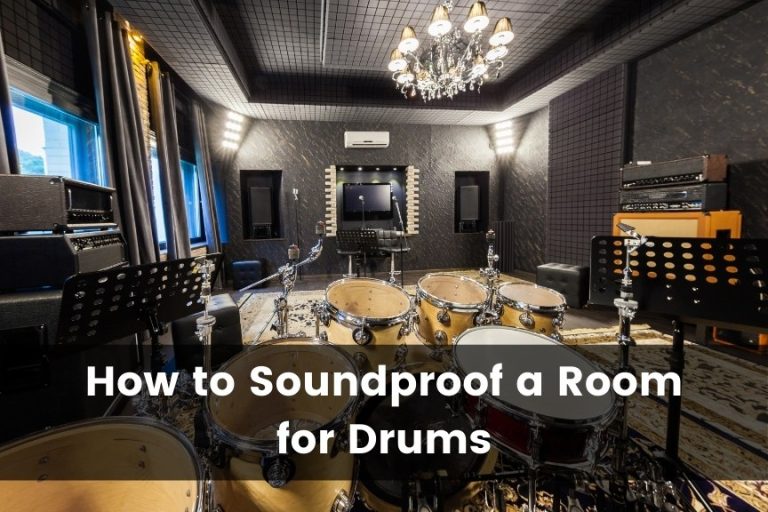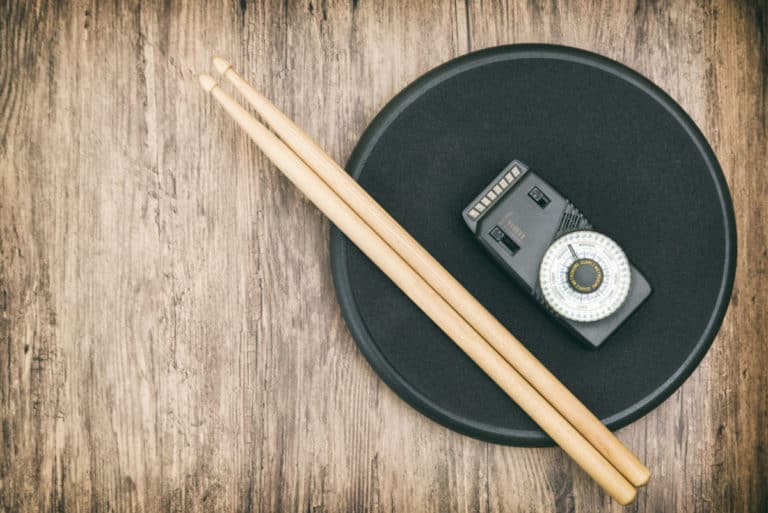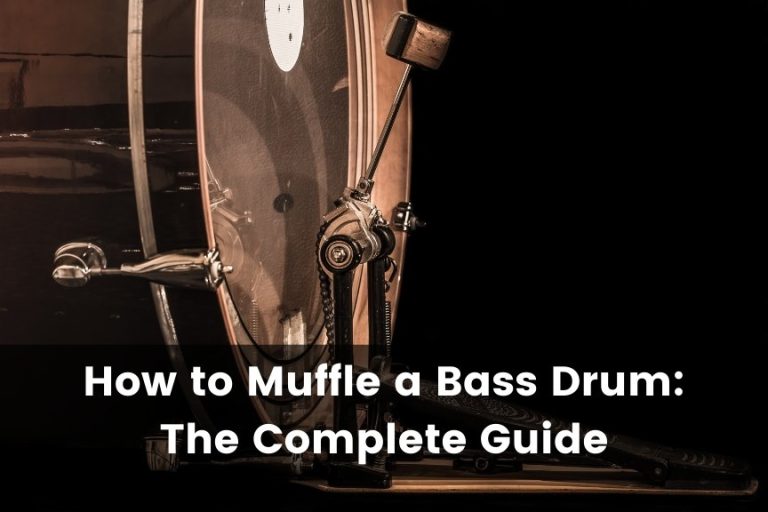Practice Pad Setup for Drummers: 8 Things to Consider
It’s always a struggle for drummers to either find a practice room or to practice at home without disturbing the neighbors – assuming you own an acoustic drum kit. This is where the invention of practice pads comes into play. Here are my thoughts and considerations all about your practice pad setup.
1. The Importance of Practice Pads
The first things I would recommend to every drummer, no matter what skill level they’re at, in terms of practice tools is to
- get a practice pad,
- practice with a metronome.
Since this article is all about the practice pad setup, I won’t go into detail about the metronome topic. In fact, I wrote a whole article about this topic which gives more exciting information. Check it out here: Do Drummers Use Metronomes to Keep Their Tempo?
When just starting out on the drum set, it is crucial to establish and maintain a good practice routine. Nothing is more important than to just keeeeep practicing! Seriously. Get your rudiments down and develop a proper hand technique. A small setup with only one practice pad will absolutely do the job. Most amateur and professional drummers do it that way.
I would say if you can split half of your practice time between the kit and the pad, you get the best results, particularly if you’re just starting out or playing for less than about 3-4 years. Because stick control is THE most important thing that is going to accelerate your playing so much, as it focusses on the basic movements that you eventually apply on the kit; that’s where it all comes together: The technique, the rudiments, and other stuff like dynamics, independence, motion and so on.
Sadly, a lot of drummers still miss out on that part and develop a sloppy technique, resulting in only minimal control. And it’s all the sadder because it is an avoidable condition.
So, a lot of pad time is really, really important when you’re starting out. Again, try to split your time half between the pad, half between the kit and you will notice significant improvements.
2. Starting Small
Now, how should you be “starting small” like what I’m writing here?
Practice pads are usually very affordable nowadays and most of the drummers, if not every drummer, owns one (even if buried in the shallows of your basement). In my recommended gear section, I’m sharing my thoughts on what practice pad is best to buy and why.
So get a practice pad, the best choice would also be to get a practice pad stand or a spare snare stand to mount it on to so you can adjust it to the correct height (see chapter 3).
If no practice pad is available, for whatever reason, you can also try different surfaces that appear in your homes, such as pillows, the seat surface of a sofa or your bed. You can even just ditch your drumsticks and play by tapping your hands on your knees to practice some hand-foot-independence.
3. Right Height Adjustment
First things first, you have to set that thing up, so where should you put it? I would say the best thing you could do is to put it on a spare snare stand. And if you don’t have a spare one laying around, that’s fine. Any flat surface will do. What you definitely want to do is to set it up at the right height for you.
The “ideal” setup would probably be to get your drum stool and put it in front of your pad that’s mounted on a stand. I mean, when being on tour and you don’t always have these things with you, you’d probably just use any surface at any height, just to practice your chops – that’s not ideal when you want to do some serious work on your stick control!
So, you want it to be at a height that – if you’re sat and playing – your hands
- aren’t resting on your legs / you’re sitting too low, and
- they shouldn’t be up too high where you extremely bend your wrists.
The ideal position is to have the pad in front of you, where the tips of the sticks fall naturally into the center of the pad, and the angle of the sticks to one another is roughly 90 degrees. The sticks should be in one line with your underarm with your wrists straight. Ideally, you also want a couple of inches clearance between your hands and your legs just to avoid hitting your legs.
4. Material Differences
When diving deeper into the topic of practice pads, you will notice a wide variety of pad surfaces. You should be aware of them, know their distinctions and choose your personal setup accordingly. So here are the most common types:
Rubber. One of the most commonly used materials is practice pads with a hard rubber surface. The rubber provides an excellent rebound but at the same time causing some noise. Depending on the thickness and type of the material, the feel can vary. Usually, they have a harder feel, potentially making your wrists fatigue after extensive practicing. This doesn’t need to be a problem for softer rubber, though.
Mesh. With mesh pads, you’ll notice they have a softer sound. In terms of feel, mesh heads tend to feel more natural than hard rubber pads, although some drummers would describe them as too soft or too bouncy. But they have a fair advantage in terms of versatility. A mesh head provides the ability to adjust the tightness of its surface. You can tune it tight for more rebound and loosen it up for less rebound and thus, to build more strength and endurance.
Multi-Surface. This developed from the idea that long practice sessions on a single-surfaced practice pad can get monotonous and redundant for some. A multi-surface pad commonly contains two to four different surface types that each have a different hardness, all within a regular practice pad size. Compared to single-surfaced pads, you’re able to hear the sticking patterns more clearly and you can be more creative.
Pillow or your bed. This has no room for excuses. Every drummer owns some sort of bed and one or more pillows. But even if it’s the most inexpensive way of practicing, it is only ideal for practicing endurance and strength, and you have to pay special attention to the appropriate height and angles setup if you don’t want to hurt yourself. But it’s a perfect and quiet way to spontaneously grab a pillow and practice a bit while watching TV!
5. What Are Your Goals?
With the help of a practice pad, everyone can pursue a different goal. The most common ones would be to develop a better technique, build up endurance and strength, or to play tighter to a steady beat.
And for all the purposes that can be different, there isn’t a “one fits all” solution. So you might want to read on to find out what would suit your needs best.
The most common goal is probably to develop good stick control. This can be achieved through nearly every standard setup, like a practice pad, or even a practice kit – made out of practice pads. The only difference between those options is: The more possibilities, the more creative freedom you eventually have.
Do you want to become stronger and gain more endurance? Then you’d have to practice on a surface that naturally requires your muscles to work heavier. You can achieve this by using very soft surfaces that don’t have much of a rebound, such as pillows, the seating surface of your sofa or your bed.
Measured by the possibility of being creative, I conclude the following from my paragraph above: If creativity isn’t so crucial for pad practice, just get a standard practice pad – nothing fancy. If you aspire to live your creativity, you should get a practice kit. For the case that you see yourself in between both ends, you might want to check out a multi-surface practice pad.
Another possible practice goal can be that you want to develop the speed of your movement between the drums, to be able to apply it on the real kit afterward. The best and most realistic practice pad setup would be a practice pad kit. You can also develop a bit of movement speed by practicing on a multi-surface pad, but it won’t be as much as on a bigger setup with multiple practice pads.
Tying in with the point of speed: Your goal can be focused solely on the speed development of your feet. Obviously, a standard round practice pad won’t suit your needs at all. For this particular purpose, bass drum practice pads were invented. Essentially, it is a construction that is holding a vertically mounted practice pad with either rectangular or round shape. It lets you mount your single or double bass drum pedal and you’re ready to go!
The last goal that I can think of what a drummer would want is developing independence. Now, independence is quite a broad topic. Of course, you can practice this on a whole practice kit with a foot pedal and multiple practice pads. But it doesn’t need to be that fancy. I think the more efficient solution here would be just to ditch all the pads, sticks and pedals. Instead, use your hands for tapping on your knees and your feet for tapping on the floor. While sitting upright and relaxed, any limb independence practice session will be enjoyable for sure.
Read more exciting stuff about independence and multitasking on the drums here!
6. What Is Your Budget?
The popular budget question mostly has an enormous impact on your final decision about what to get. For a better overview, I’m going to group the budgets into the most sensible price ranges. And for every range, I would decide on the best options depending on your goals that you should’ve figured out after chapter 5.
I have just as much as $0 to spend! Alright. It might seem hard to find a good practice pad setup for such a tight budget, but it’s certainly possible to find an appropriate fit for your needs. Actually, you still have a choice between a few options:
- For strength and endurance, practice on soft surfaces like pillows or your bed.
- Assuming you already own a pair of drum sticks: Decorate your bed with differently soft pillows and your duvet, and then practice “moving around the kit”. So it’s an excellent combination of the development of creativity, strength, endurance, as well as movement speed.
I’ve got no more than $5. Assuming you already own a pair of drum sticks: Buy a rubber pad at your local hardware store and creatively use that as a practice pad replacement.
I can spend up to $20. With 20 dollars, you might not have enough to get a proper practice pad. Instead, the market has a small version of it to offer, and they’re called “knee practice pads“. They have a strap that lets you fixate the pad onto one of your knees while sitting upright and having your legs in about a 90-degree angle — a good way of practicing stick control on the go.
I have $30-40. Perfect! Because this enables you to buy a practice pad! The average price of a practice pad is around this price mark. Some pads cost more than others, but I think this budget will get you a good and long-lasting product with which you can practice your stick control.
My budget goes up to $70. That’s quite a budget for a practice pad. You can easily get a practice pad with multiple surfaces within that price range, like the DW Multi-Surface Pad, or the Drumeo P4.
I don’t care how much it costs. Get a full practice pad kit. I’m thinking of the DW “Go Anywhere” Practice Kit that I actually own myself and couldn’t ask for a product. It makes you be able to develop stick control, creativity, speed, and independence. That’s everything except strength because it doesn’t provide soft surfaces.
Keep in mind that you can always combine the different setups to fit your budget and your goals. For example, you can get a big practice pad kit, which lets you practice everything but strength, so you add some practice time on a pillow that complements the purpose really well.
7. Noise Level
Unfortunately, the volume is always a problematic topic when it comes to drumming. Now, regarding your ideal practice pad setup, the volume would be as low as possible. The only sounds should be the ones from hitting a practice pad, at best, one that’s extra quiet, or a pillow.
If you have some freedom of sound levels where you have your setup, it opens up a few more possibilities. For example, you can add some cymbals to your practice kit. Zildjian makes these low volume cymbals that basically contain lots of small round millings side by side. They are not as quiet, though. But it should be alright for a normal noise level that you have in a room.
The same thing goes with drumheads. Remo has their silent stroke heads, which are made out of mesh and replace the batter head of your drum set. This solution is not as quiet, because when mounted on your acoustic kit, you still have the resonant heads that will swing with your hits. But because the mesh heads don’t even produce such a loud sound, the resonant heads, therefore, vibrate much less.
You can arrange this as you like. Use the silent cymbals with your acoustic kit that is equipped with the silent heads, with your regular practice pad kit, or whatever you want.
Another option of tools available for making your acoustic kit quieter is to use special dampers. There are dampers which you place on the drumheads, as well as on the part of the cymbal that you’re hitting. On their upside, they are way cheaper than the silent heads or cymbals I pointed out above. The best one I’ve ever heard of are the Evans SoundOff Dampers. They are available for the snare, toms, cymbals and bass drum. Maybe give it a try and see if it suits your setup!
8. Impact Sound
Impact sound is linked a bit to the preceding topic of the noise level. Let me first clarify what impact sound means, regarding the playing of a quiet practice kit with or without using foot pedals.
The problem is not the noise the pads make while playing, it is usually enough to close the door to the next room and that’s it. The problem lies in the vibration that goes through the linkage into the floor, spreads through the walls into the other rooms and even apartments. The whole room suddenly also becomes a resonating body in itself and even amplifies the initial quiet noises into a booming and banging that is unpleasant for the others as if someone is drumming against the walls with his fists.
Now there are different approaches and I invite you just to try them. The most important principle is: “Your kit must be off the floor!” It’s called “decoupling.” When there is no direct contact with the ground, the problem is solved. For all those who own their own house, the problem is straightforward and inexpensive: “Just put the set on the ground floor – done”.
In fact, the ground floor conducts the energy into the earth, making it less of a problem. But for those who don’t have a choice because they want to practice in an apartment that is not on the ground floor, there are also reasonable solutions, like a podium, which basically consists of an acoustic panel, halved tennis balls and possibly a carpet. You can also buy vibration dampeners for all feet of your drumset, which are available for washing machines. Under each foot, one damper – done.
